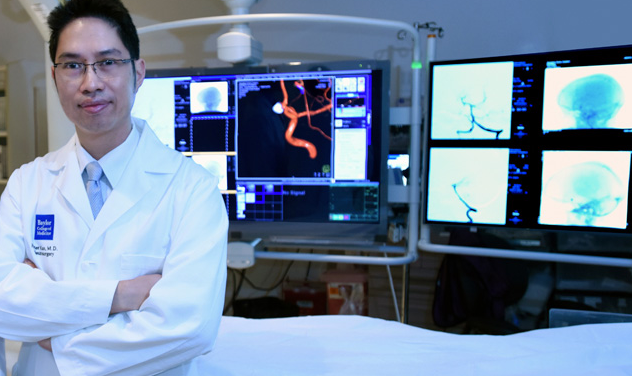Know your risk for brain aneurysm
According to the Brain Aneurysm Foundation, a ruptured brain aneurysm occurs every 18 minutes in the United States. But what exactly is a brain aneurysm?
A brain aneurysm occurs when there’s a weak area in the wall of an artery that supplies blood to the organ, which causes an unusual swelling. In rare cases, this swelling can rupture and release blood into the skull causing a stroke, hemorrhage or even death.
Dr. Peter Kan, associate professor of neurosurgery and director of cerebrovascular surgery at Baylor College of Medicine, discusses aneurysm warning signs, risk factors and common treatment options.
What causes an aneurysm?

The exact cause of brain aneurysms is unclear. However, certain factors can contribute to the condition. Kan notes the following three risk factors:
- Smoking: The use of cigarettes may greatly increase the chances of a brain aneurysm rupturing because smoking or chewing tobacco can damage the lining of your artery walls
- High blood pressure: Having high blood pressure can damage your arteries. Over time, the pressure of blood moving through a weakened artery can cause an aneurysm. Uncontrolled high blood pressure can cause brain damage via a stroke or other debilitating conditions
- Family history: People who have a family history of brain aneurysms have a higher risk of developing the condition than those who don’t
In addition, women are more likely than men to develop a brain aneurysm and those who have had an aneurysm in the past are more likely to have another.
Warning signs
Brain aneurysms may not present any signs or symptoms and indicators of a ruptured brain aneurysm often come on suddenly.
“Sometimes, a very severe headache can be a warning sign that an aneurysm is pending to rupture,” Kan said. “This is typically much different than a migraine.”
“People with a ruptured aneurysm typically describe their headaches as the worst headaches of their lives while migraine headaches are typical headaches well-known to the patient,” he said. He adds that double vision, trouble with eye opening, and weakness can indicate a brain aneurysm as well.
Treatment options
There are various procedures are used to treat both ruptured and unruptured brain aneurysms. Endovascular embolization is a minimally invasive procedure that uses coils to fill the inside of an aneurysm so that blood cannot get in. Surgical clipping, on the other hand, requires a neurosurgeon to place a small clip across the aneurysm to prevent or stop it from bleeding.
Kan says patients can get a non-invasive screening study done with a magnetic resonance angiography (MRA) scan without contrast if they suspect they may have an aneurysm. “This is free of radiation and is risk-free to the patient,” he said.
To schedule a visit with the Neurosurgery Clinic at Baylor, call 713-798-4696 or request an appointment online.
-By Alexandria Bland, communications coordinator with the Departments of Neurology and Neurosurgery at Baylor



